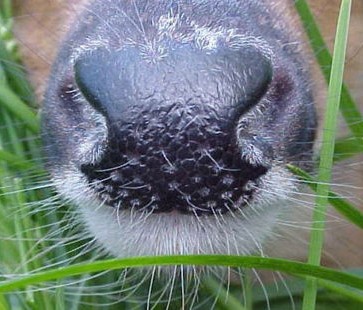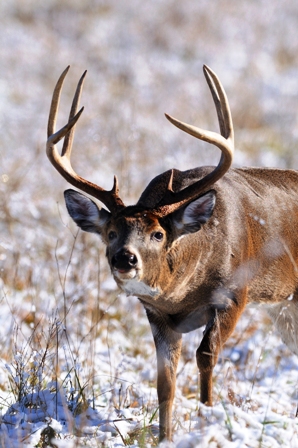27 Jan BLOWN!!!
Deer have several layers of defense. Their senses are amazing. When the deer rely on their senses, they are hard to kill. When they are pushed, distracted by the Rut, panicked, or weather becomes a factor, their defense layers become less of a concern. Deer become most vulnerable when they cannot use their Nose!
Getting busted by a deer or elk means the hunt is over. The getting up early, long drive, walking into the forest, and practicing all your hunting skills just got Busted! The deer smelled you coming.

The sense of smell is the most important defense for a deer. Their elongated nose allows their olfactory sense to smell maximum scent. To overcome a deer’s defenses, you need to first overcome their sense of smell.
Good luck with this! In Montana, elk are super sniffers. They live in hard-to-reach places which require long, hard sweaty, exercise. Your clean body smell reeks in 10 minutes of climbing the mountains. There is simply no way to keep yourself scent free. I have seen elk wind hunters a mile away. The scary thing is that Grizzly Bears can smell a gut pile from 20 plus miles away, under the right conditions.
Most hunters that I have talked with rarely consider the wind. They march toward their stands and have no clue about the wind. When they hunt waterfowl, these same hunters wonder why the geese and ducks are landing in the wrong place. Of all the things to ignore, wind should last on the list.
Knowing wind direction can be as simple as feeling the wind on your face. Carrying a wind checker, filled with light powder, will also float along in the wind. Squeeze the checker and wind direction is revealed. You can make your own Wind Checker using a squeeze bottle filled with Carpenters stringline chalk. I use an empty Elmer’s Glue container filled with white chalk. The locking cap keeps the chalk from spilling out.
Natural materials also work well. Try carrying a pod of Milkweed seeds. Pull out a tuft of seed material and watch the wind carry it away. The milkweed fibers will react to the slightest wind. If you are worried about spreading seeds, you can pull them off before you put them into a container.
Once you know the direction of the wind, hunt into it. In Montana, we hunt into the smell of elk. If you are smelling elk, they are not smelling you. This gets tricky at 20 yards when the wind shifts or swirls, but you get within 20 yards. Learning to hunt with your nose takes practice. Antelope and deer stink too. You just need to learn the smell.
Cover scents may help when on stand or in a blind. You will get the critters coming in downwind when they smell a rut or other attractor scent. As they close, deer can differentiate the smell, so you need to be ready. If you place the scent on your stand or body, they will be looking at you! They can also see twice as far as a human and have exceptional night, or low light, vision.
Place the scent where you want to shoot the deer. One trick that I used was to add a scent cloth to an old arrow. Once in my stand, I would check the wind and figure where the deer would approach, upwind, from. I scented the rag and shot it exactly where I wanted the deer to stand. I cannot tell you how many deer were shot smelling that rag. Using the wind to work for you is vital.

I also used scent rags to attract the deer to my stand. Once I knew the wind direction, I would approach my stand cross winded. At 100 yards I would place a scent bomb. Every 20 yards I would repeat the process. Usually, I used a Rut scent. The scented rag would drag from a string behind me. My scent line would be 200 yards long, with my stand in the center. I would place my scent rag where I hoped to get my shot. The crosswind carried a 200-yard wall of scent from my stand. Any Buck that passed downwind would come over to check it out. Once they hit my scent line, they would travel toward my stand. Since the scent rag was always dragged toward my stand, the leaves and flipped debris would hold scent as if a deer’s feet moved them. Use the wind to avoid getting Busted.
Rocky Jacobsen is a hunting friend that owns Rocky Mountain Game Calls. As a member of his Pro Team, I use all his products. They are excellent. Made by a true hunter for hunters. Anyway, when Rocky does a seminar, he talks about how a deer or elk will react to a hunter’s presence. “They will hear you 3 times. See you twice but smell you once!”
If you are getting Blown up by deer, you will know it. They wheeze and snort. They also head to the next county.
Wind constantly changes. The hunter also needs to change with the wind. It may mean a different stand location, change direction of your still hunt, or repositioning your attractor scents. Waterfowl hunters know this all too well. They usually set their decoys with an opening for the birds to land. It is where you plan to shoot. If the wind changes, the birds will land outside of gun range. Make the adjustments as needed.
I once hunted with a heavy smoker. He reeked of tobacco. His clothes, gear, breath, stand sites all reeked. When I approached his stand down wind, I could smell him hundreds of yards away. The crazy thing was that he always tagged out. He knew how to hunt and read the wind. Once he knew wind direction, he would plan a different approach to his stand. He would use his attractor scents to bring the deer into range, but away from his stink. It would have been less effort to simply stop smoking but he could not.
Getting Busted by a deer or elk is the hunter’s fault. Take ownership and figure it out. Otherwise, it will happen repeatedly. It is smart to keep your body and gear scent free or smelling like the area that you hunt. This helps until you begin to sweat. Now you better know which way the wind blows.
When hunting the wind, you will know immediately. Suddenly you will see more critters, closer shots, and greater success.
Don’t Get Busted!
Montana Grant
For more Montana Grant. Smell him at www.montanagrantfishing.com.


